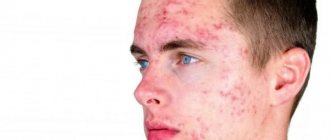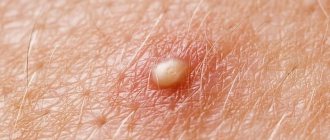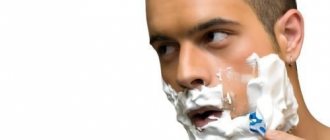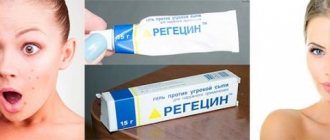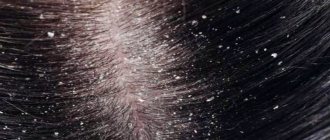Difficulties in treating demodicosis
When using the most effective acaricidal drugs (chemicals that reduce the number of ticks), treatment often turns out to be ineffective, which is due to the special structure of the external integument of ticks, their larvae and eggs.
The outer shell of the tick is three-layered, especially developed in females. It protects the parasite from external influences. The cuticle has pores - special channels through which water and gas exchange occurs, but large molecules of contact-acting acaricidal agents cannot penetrate. This fact dictates the need for long courses of antiparasitic treatment.
Rice. 3. Demodex mites (view under a microscope).
What is demodex?
Demodex mites infect the skin of the forehead, cheeks, chin, wings of the nose, and the area of the outer ear. Under normal conditions, the microorganism removes the stratum corneum of the skin and sebum residues, but under a certain condition, it begins to multiply vigorously, causing a disease called demodicosis.
The life cycle of microorganisms is 15-20 days. Reproduction by laying eggs, and after laying the microorganism dies in the sebaceous gland. After 60 hours, larvae appear that feed only on lard and epidermal cells. After 72 hours they begin to move, clearing the skin, and after 60 hours they lay eggs.
Due to the strong proliferation of microorganisms and the large number of dead individuals from which waste products come out, the pores become contaminated. As a result, pink pimples appear.
At temperatures above 14 0C, the tick’s vital activity increases, but on the contrary, the process slows down. Therefore, the spring-summer period contributes to the appearance of the disease.
Interesting! Outside of a person (host), the tick cannot live and dies.
Features of therapy for facial demodicosis
When choosing antiparasitic treatment, it is necessary to take into account the clinical picture, severity of the disease and concomitant pathology of the patient.
Complex treatment of demodicosis
Treatment of demodicosis should be comprehensive and include acaricidal, anti-inflammatory (including antibacterial), desensitizing drugs and immunomodulators. The patient’s body must receive the required amount of vitamins, minerals and amino acids. If demodicosis occurs against the background of existing skin diseases, they are treated.
Stages of treatment for demodicosis
- At the first stage of treatment, anti-inflammatory drugs are used, hyposensitizing therapy and immune correction are carried out.
- At the second stage of treatment, antiparasitic therapy is carried out.
- At the third stage, drugs are prescribed that reduce sebum secretion, improve the condition of blood vessels and their regulation.
Duration of treatment for demodicosis
Treatment of demodicosis is long-term. Depending on the form and stage of demodicosis, treatment can be extended from 4 weeks to 1 year.
Criteria for the effectiveness of treatment of demodicosis on the face
The criterion for the effectiveness of treatment of demodicosis on the face is the reduction or disappearance of clinical manifestations of the disease and a decrease in the number of mites according to the results of the analysis.
The duration of treatment for demodicosis is dictated by the structural features of the parasite. The effect of the therapy becomes noticeable after 2 - 8 weeks.
Rice. 4. Long mites Demodex folliculorum longus live in hair follicles in groups (picture on the left) and rise to the surface at night to mate. Short mites Demodex folliculorum brevis (picture on the right) live in the mouths of the excretory ducts of the sebaceous and meibomian glands alone, rarely rise to the surface, which makes them difficult to detect and treat.
Characteristics of the tick
The culprit of blockage of the sebaceous glands and damage to external tissues is a microscopic mite - Demodex folliculorum/brevis (D. Folliculorum/brevis). It loves to settle and reproduce in these formations, which provokes the development of the disease. It is transmitted only between people; it is impossible to get infected from an animal (dog, rodent, cat and others), since species live on their skin that are not adapted to life in human glands.
The tick is a mobile microorganism, with an average speed of 13-18 mm/hour. It can easily move along the integumentary tissues to a new habitat. This “migration” is constantly carried out by a large number of parasites, although this is not visible to the eye. That is why infection occurs very easily - through any contact with the patient or his household items (towels, bed linen, clothes, etc.). Demodex quickly finds a “home” and remains with the new owner until treatment is carried out.
Where can a tick live? On any part of the skin, including the eyelids, perineum and armpits, where there are sebaceous glands. Other parts of our body are unsuitable for it. That is why it makes sense to look for signs of the disease only in these areas. A comfortable temperature for this arachnid is 37-40°C, so in warm rooms and in hot climates it begins to actively reproduce, which leads to the activation of pathology.
Anti-inflammatory therapy
- At the first stage of treatment, it is necessary to use drugs that suppress the microbial population. For this purpose, anti-inflammatory drugs for external and systemic use are used. Ointments, creams and gels with antibiotics for external use have a good effect: Metronidazole, Tetracycline or Erythromycin.
- In advanced forms of the disease, antibacterial drugs are used orally. Metronidazole (Trichopol), Tetracyclines, Ornidazole, Monocycline, Doxycycline, Roxithromycin, Erythromycin are shown.
Rice. 5. Metronidazole and Trichopolum are widely used for demodicosis.
Metronidazole for demodicosis
For many years, derivatives of the nitroimidazole group Metronidazole and Ornidazole have been used to treat demodicosis. The drugs have anti-inflammatory, anti-edematous and immunomodulatory effects. They are active against bacteria, single-celled parasites and Demodex mites. They are used internally and externally in the form of creams, ointments and gels.
Metronidazole is used orally for 2 - 4 weeks, 250 mg 3 times a day (standard regimen). Analogs of the drug for internal use are Trichopolum, Klion, Flagyl, etc.
The drug of choice for demodicosis is Ornidazole (Ornisol). It is stronger than metronidazole, well tolerated, and has fewer side effects. Used in courses of 10 days, 500 mg 2 times a day.
For external use it is used:
- Trichopolum cream for demodicosis is used for one and a half months, which is associated with the life cycle of the demodex mite. In advanced cases, treatment is prolonged.
- 1% cream and gel Metrogyl (contains metronidazole). Apply 2 times a day for 3 - 6 weeks.
- Rosamet cream containing metronidazole is applied 2 times a day for 3 to 9 weeks.
- Contains metronidazole, a multicomponent remedy used for demodicosis, Demalan cream. It has anti-inflammatory, dermatropic, antibacterial and antiparasitic effects. It is used for demodicosis of the face, eyelids and ear canal.
- Erythromycin ointment is applied 2 times a day. Do not use the drug for more than 5 weeks due to the rapid development of resistance of microorganisms. For acne, the complex “erythromycin - zinc acetate dihydrate” has a good effect. The prepared solution is applied to the affected areas of the skin 2 times a day - in the morning under makeup and in the evening after washing for 10 - 12 weeks. The drug relieves inflammation and has a comedolytic effect.
- Contains erythromycin and zinc acetate dihydrate Zinerit powder.
Rice. 6. Rosamet cream and Metronidazole gel are preparations for external use.
Rice. 7. Zinerit powder contains erythromycin and zinc acetate dihydrate.
What is demodicosis
The described disease is characterized by damage to the skin by a special type of mite - demodex. Sebaceous glands and hair follicles are home to this parasite. This means that signs of demodicosis can be found in the face, ears, eyelids, nasolabial folds, eyebrows, and so on. The named parasite chooses for itself those places in which the sebaceous glands work as actively as possible.
If the person’s immune system is in excellent condition, then the mite can be located directly in the upper layers of the skin, while feeding on dead cells. But as soon as the body’s defenses are weakened, the tick penetrates deeper, and then the first signs of demodicosis can be noticed.
In fact, more than seventy percent of the earth's population are carriers of this parasite. At the same time, women with delicate light skin are affected much more often than representatives of the stronger sex.
Signs of demodicosis can be seen especially clearly if you examine the hair follicle under a microscope. There you will notice an incredibly huge accumulation of colorless mites that have already managed to attack your body.
Permethrin for demodicosis
After the disappearance of inflammation, the transition to the treatment of demodicosis with antiparasitic drugs is carried out.
Insecticidal preparations containing permethrin (a group of pyrethroids) have a powerful antiparasitic effect against demodex mites. Pyrethroids penetrate the cuticle of mites and concentrate in the hemolymph. They bind to the lipid structures of nerve cell membranes, disrupt the functioning of sodium channels, which leads to a slowdown in the repolarization of cell membranes with subsequent death of parasites. The substance permethrin does not enter the human systemic circulation.
4% Permethrin ointment is applied to the affected areas of the skin and rubbed in with massaging movements. After 24 hours, the ointment is washed off with warm water and soap. A single procedure is often sufficient. But sometimes the procedure needs to be repeated, which is allowed after 14 days.
Other insecticidal preparations:
Spregal spray is used for scabies, but also has a pronounced effect against iron mites. It contains the antiparasitic agents esdepaletrin (esbiol) and piperonyl butoxide. Spregal spray is irrigated onto a cotton swab, through which the drug is rubbed into the affected areas. A positive effect is achieved in 80% of cases.
In some cases, insecticidal preparations such as Crotamiton (cream), Malathion (emulsion concentrate), Lindane (emulsion), Benzyl benzoate (emulsion, ointment, cream and gel) have a good effect on demodicosis. Benzyl benzoate is applied at night to the affected areas of the skin after washing. The course of treatment is 2 - 3 weeks.
Rice. 8. Insecticidal preparations Permethrin and Crotaderm. Used in the treatment of demodicosis.
Rice. 9. Insecticidal preparations Lindane and Benzyl benzoate are used in the treatment of demodicosis.
Rice. 10. Spregal spray has a pronounced effect against iron mites.
Recommendations and useful tips for treatment
To achieve more visible treatment results, dermatologists advise following the following recommendations:
- Cleanse the skin daily with special preparations that eliminate excessive oily sheen;
- Do not use hot water for washing , this procedure disrupts the natural protective functions of the skin;
- Reduce skin touching , especially in the facial area. A person’s hands may contain a large number of bacteria that contribute to the disruption of the structure of the skin and can cause the development of mites;
- Ensure the cleanliness of personal hygiene products and items for applying cosmetics;
- Avoid prolonged exposure to direct sunlight;
- Replace the feather pillow with padding polyester , very often down can cause a reaction and provoke the occurrence of demodex;
- Do not apply cosmetics in large quantities ; this method of applying cosmetics leads to clogged pores and the development of skin mites.
Experts recommend following such facial care methods even in the absence of tick infestation, as well as during treatment with medications.
Tar and sulfur ointment for demodicosis
When treating demodicosis, preparations containing sulfur and tar are used.
8% Sulfur ointment is one of many drugs that have an antiparasitic effect. Sulfur interacts with organic substances and forms pentathionic acid and sulfides, which have a detrimental effect on ticks. Sulfides have a keratoplastic effect. Sulfur ointment is applied to a cleansed face at night. The course of treatment is 7 - 10 days. Panthenol is used to prevent dry skin, burns and minor injuries. The drug is available in the form of cream, ointment and emulsion.
Demoten and Delex-acne gel and Delex-acne lotion are multicomponent preparations that contain sulfur. In addition to antiparasitic drugs, they have anti-inflammatory, antiseborrheic and keratolytic effects. The lotion cleanses the skin well.
Yam ointment was developed and used to treat animals. However, as it became known, it has proven itself well in the treatment of demodicosis in humans. The components included in its composition (sulfur and tar, carbolic acid and Lysol, turpentine and lanolin, natural ichthyol and medical petroleum jelly) have antiparasitic, antifungal, antiseptic and keratolytic properties. The drug belongs to hazard class 4, that is, it is considered a low-hazard drug. On the first day, the ointment is applied to the affected areas of the skin for 15 minutes, after which it is removed with vegetable oil. After the procedure, the skin is lubricated with moisturizing and nourishing cream. If the treatment is well tolerated, then gradually the duration of the application is increased to 1.5 hours, increasing by 5 minutes daily. After which the application time must be gradually reduced until the drug is completely discontinued.
Manting, Xin Fumanling and Mefule are Chinese medicines. There are many positive reviews on the Internet about them in the treatment of demodicosis, which is due to the fact that they contain sulfur in their composition. Demodex Complex products are a complete copy of the above drugs, but are much more expensive.
Rice. 11. Sulfur ointment is widely used in the treatment of demodicosis.
Rice. 12. Demoten and sulfur-tar ointment for the treatment of demodicosis.
Rice. 13. Yam ointment has proven itself well in the treatment of demodicosis in humans (photo on the left). Delex-acne is a multicomponent preparation that includes sulfur (photo on the right).
Features of the treatment of some forms of demodicosis
Treatment of resistant strains
Despite the positive results obtained in the treatment of demodicosis with classical means, treatment-resistant and recurrent forms of the disease have become increasingly common in recent years. So, if resistance develops, it is recommended to use cryotherapy in combination with the use of Rosamet cream containing 1% metronidazole.
Treatment of papulopustular rashes
When treating papulopustular rashes, it is recommended to use classic reducing (restorative) agents - zinc-ichthyol ointment, 1 - 2% tar and ichthyol ointments, 1% ichthyol-resorcinol paste. Contains zinc hyaluronate gel Curiosin.
Treatment of acneiform demodicosis
In case of persistent acneiform type of demodicosis and in case of development of resistance (resistance) to antiparasitic drugs, it is recommended to use drugs of the retinoid group (they are structurally close to vitamin A). Retin-A (Tretinoin), a synthetic analogue of retinoic acid Adapalene (Klenzit, Differin) are used topically. The systemic retinoid isotretinoin (Roaccutane) is prescribed for severe acneiform demodicosis.
Rice. 14. Preparations of the retinoid group are used in the treatment of demodicosis in case of resistance development. The photo shows 0.1% Retin-A cream.
Rice. 15. Acneiform form of demodicosis: papular (photo on the left) and papulopustular (photo on the right).
Rice. 16. The effectiveness of treatment of acneiform demodicosis.
Rice. 17. Rosacea-like form of demodicosis: in the form of diffuse erythema (photo on the left), granulomatous form (photo on the right).
Demodectic mange and rosacea
Demodicosis in humans complicates the course of rosacea in 88.7% of cases. This mainly occurs in the later stages of the disease - erythematous-papular, papulopustular and nodular. The basis of therapy for demodicosis and rosacea is the correction of pathology of internal organs and the use of external treatment agents.
- For the treatment of demodicosis and rosacea, the use of sulfur-containing drugs and benzyl benzoate is recommended. The aerosol preparation “Spregal” has a good acaricidal effect.
- For external use when papules and pustules appear, the use of salicylic acid, resorcinol, adrenaline, etc. is recommended.
- Prevents the appearance of compactions in the outer layers of the skin and eliminates redness gel and ointment with azeloic acid gel and cream Skinoren.
Rice. 18. The photo shows Skinoren gel and Azix-gel cream. Contains azeloic acid.
Appearance of the parasite
Most often, iron ore or iron ore mites, demodex, appear on the skin. Outwardly it looks like a white, translucent worm. Body size does not exceed 0.4 mm. Movement and fixation are carried out by four pairs of limbs. The first are the oral apparatus. The remaining paws have sharp claws. A photo of a subcutaneous mite on the face can be seen below.
The parasite is localized in the area of the sebaceous glands and hair follicles. It affects the skin of the face, less often the neck, chest, back, and shoulders. About 4 glands are concentrated in one hair follicle. The main sign of the development of demodicosis is acne.
Skin mites on the face go through several stages of development.
- It all starts with a microscopic egg. The female deposits them on the surface of the epidermis.
- After a few days, it transforms into a larva with three pairs of limbs and the absence of respiratory and genital openings.
- The next stage is the nymph, which goes through several stages of its development. On the latter, a fourth pair of limbs appears, the genitals.
- The final formation of the reproductive system is completed in adult ticks - adults.
A photo of a tick on the face at different stages of development is presented below.
On a note!
The subcutaneous mite is present on the skin of every person, but does not cause discomfort and is completely invisible. Acne does not always appear. And only under certain circumstances does it begin to actively reproduce, which causes a difficult-to-treat disease - demodicosis.
Demodex mite at different stages of development
Demodectic mange against the background of seborrheic dermatitis
When demodicosis appears against the background of seborrheic dermatitis, the use of Retinoic ointment is indicated. It prevents the development of increased proliferation of the epithelium of the excretory ducts of the sebaceous glands, reduces the production and evacuation of sebum, helps reduce the inflammatory component and promotes the regeneration of the skin. The simultaneous use of tetracycline antibiotics and glucocorticoids is not recommended.
For seborrheic dermatitis, it is recommended to use drugs containing azeloic acid: Skinoren, Azelik, Azix-derm, etc. Skinoren is used in the form of a 15% gel or 20% cream 2 times a day. Improvement occurs after 4 weeks.
Rice. 19. When demodicosis appears against the background of seborrheic dermatitis, the use of Retinoic ointment is indicated.
Causes of demodicosis
As we said earlier, demodex, a mite that provokes the development of this disease, is present in the body of every person. However, some are being treated for demodicosis, while others do not even know what this pathology is. In its normal state, demodex exists painlessly in our body, cleansing it of toxins. But as soon as the conditions familiar to him change, problems begin. Ophthalmologists distinguish two degrees of pathology: primary and secondary. The primary one is formed on healthy eyelids, and the secondary one occurs against the background of other skin diseases, for example, in the presence of papillomas, various neoplasms and eye diseases. Various factors can provoke the development of this disease, including:
- heatwave;
- the effect of ultraviolet rays on the visual organs;
- too frequent or, conversely, too infrequent bathing;
- general decrease in immunity or disease of the immune system;
- increased acidity of the skin;
- decreased vision due to myopia or farsightedness.
The list of reasons that provoke the development of demodicosis can be much wider. Usually, ophthalmologists include general diseases of the body in it: common acute respiratory viral infections or acute respiratory infections, as well as disturbances in the functioning of the endocrine and nervous systems or the recovery period after eye surgery, for example, during cataract removal.
Demodicosis with acne
Demodicosis in humans complicates the course of acne in 33% of cases. Its treatment uses only an integrated approach and long-term pathogenetic therapy against the background of basic facial skin care.
Read more about acne treatment and facial skin care in the article “Modern methods of treating acne.”
Rice. 20. The photo shows acne on the face.
Hygiene
Complex therapy of the disease will be successful if the rules and recommendations are followed:
- Regularly put a clean pillowcase on your pillow. It is advisable to replace the feather pillow with a pillow with synthetic filling. It is permissible to place a cloth napkin under your head and wash it daily. The pillowcase or napkin must be ironed with a hot iron on all sides.
Demodectic mange on the face is difficult to treat. It's easier to take preventative measures - Wash with heated, settled water or decoctions of medicinal herbs. Use products containing tar. Dry your wet face not with a rough towel, but with soft sanitary napkins.
- It is recommended to clean and wash hats, gloves, scarves, and neckerchiefs more often.
- Keep glasses and shaving utensils clean: treat with soap or alcohol solution.
- Use only personal cosmetics. When purchasing a cream, it is advised to choose a tube rather than a jar. This will prevent the cream from becoming contaminated and pathogenic bacteria from entering it.
- It is forbidden to stay in the sun for a long time, take a steam bath and sauna, or sunbathe in a solarium. Heat increases the outflow of sebaceous cells, which provokes the proliferation of demodex.
- Do not touch your face with dirty hands.
- Try to avoid stress and mental tension.
- Reduce time watching TV and working on a personal computer. This reduces immunity.
The appearance of the first symptoms of demodicosis on a person’s face is a reason to immediately consult a doctor. The dermatologist will order tests and then prescribe treatment. There are various ways to get rid of ticks. A favorable outcome of therapy depends on the accurate implementation of the doctor’s orders and the prescribed treatment regimen.
Article design: Vladimir the Great
Skin care during treatment of demodicosis
- Increased production of sebum and excessive proliferation of the skin epithelium creates good conditions for the proliferation of iron mites, so daily cleansing of the skin is a mandatory procedure in the treatment of demodicosis on the face and other parts of the body. Foams, gels and lotions are used for this purpose. They remove excess oil and do not dry out the skin. The use of soap is not recommended. The frequency of washing during the treatment of demodicosis should not exceed 1 - 2 times a day. Cleanance gel and medicinal cosmetics from the Exfoliak, Klerasil Ultra, Cetaphil, Sphingogel, Sebium and Zeniak series cleanse the skin well.
- Degrease and disinfect the skin with alcohol solutions with antibiotics (5% chloramphenicol), 2 - 5% solution of salicylic acid, 2% resorcinol, 5 - 10% alcohol solution of camphor.
- Iron mites feed on epidermal cells and sebum, so when treating demodicosis, keratolytic and antiseborrheic agents should be used. The following have keratolytic properties: Benzoyl peroxide (Baziron, OXU-5, OXU-10, Klerasil-ultra), drugs from the retinoid group, Azeloic and Salicylic acids, Resorcinol.
- In case of increased skin dryness, irritation and peeling, the use of moisturizing creams and gels is indicated. The soothing cream “Klin AK”, “Aven for hypersensitive skin”, “Tlerance Extreme” has proven itself well.
- For the purpose of regeneration (restoration) of damaged areas, the use of the restoring cream “Sicalfat” with a zinc-copper complex or “A-Derma Epithelial A.N DUO Restoring Cream” with hyaluronic acid is recommended.
- To prevent the formation of atrophic scars after pustules, it is recommended to use Contractubex gel. Used for 4 weeks.
- Constant humidity and darkness are optimal conditions for the life of iron mites, so it is better to avoid cosmetics during treatment.
- Excessive ultraviolet exposure should be avoided. An increase in the production of vitamin D under the influence of ultraviolet radiation leads to the activation of the synthesis of cathelicidins, which support the inflammatory process.
Rice. 21. Salicylic acid and Resorcinol have keratolytic and antiseborrheic properties.
Rice. 22. Baziron is effective in the treatment of inflammatory elements on the skin and has keratolytic properties. The drug is available in various forms (cleansing gel, tonic, scrub, corrective preparations), which makes it convenient to use in various settings (at home, at work, while traveling, etc.).
Stages of development of demodicosis
In total, we can distinguish 4 stages of development of demodicosis, from initial to advanced. Moreover, if at the initial stage you can try to cope with folk remedies, then at the advanced stage you will definitely have to contact doctors to prescribe treatment and control. Let's take a closer look at each stage of the disease:
- Prodromal period. Characterizes the onset of the disease. Symptoms at this stage are not strong enough or are absent altogether. The main symptom is minor redness that does not have clear boundaries. It is important not to skip this stage, then the success of treatment will be almost 100% and you will not have to see a doctor.
- Erythematous period. This period is characterized by more pronounced symptoms - red spots become clearer and more noticeable. Acne appears on the face, which is accompanied by severe itching. At this stage of the disease it is still possible to be successfully cured. Drug treatment will help get rid of parasites, and creams and additional care will help bring the skin back to normal.
- Papulopustular stage. The third, more serious stage of demodicosis. The face becomes covered with nodules, which soon turn into purulent formations. We advise you to seek medical help as quickly as possible, because traditional methods of treatment will definitely not help. This stage is considered quite advanced.
- Hypertrophic period. The last stage of development of demodicosis. The patient sees the formation of large bumps on the face, thickening of the skin, the appearance of ulcers, the nose becomes enormous in size, and its skin changes color to violet-blue. Be prepared for expensive and lengthy treatment using a variety of methods. Do not self-medicate; be sure to consult a doctor so that he can draw up a treatment regimen for demodicosis at this stage. It should include not only medications, but also diets, the use of specialized cosmetics, etc.
